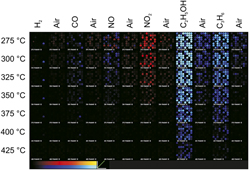Crossref Citations
This article has been cited by the following publications. This list is generated based on data provided by
Crossref.
Lipatov, Alexey
Varezhnikov, Alexey
Wilson, Peter
Sysoev, Victor
Kolmakov, Andrei
and
Sinitskii, Alexander
2013.
Highly selective gas sensor arrays based on thermally reduced graphene oxide.
Nanoscale,
Vol. 5,
Issue. 12,
p.
5426.
LIEBERMAN, MARK
MURESAN, RADU
YANG, SIMON X.
and
DOYLE, DAVID
2013.
HILBERT–HUANG TRANSFORM FOR FEATURE EXTRACTION OF TEMPERATURE MODULATED MOS SENSORS.
International Journal of Information Acquisition,
Vol. 09,
Issue. 03n04,
p.
1350014.
Belle, Clemens J.
Wesch, Günter E.
Neumeier, Stefan
Lozano-Rodríguez, M. Janeth
Scheinost, Andreas C.
and
Simon, Ulrich
2014.
Volume-doped cobalt titanates for ethanol sensing: An impedance and X-ray absorption spectroscopy study.
Sensors and Actuators B: Chemical,
Vol. 192,
Issue. ,
p.
60.
Dong, Hailong
Roming, Marcus
and
Feldmann, Claus
2015.
Unexpected Fluorescence of Polyols and PEGylated Nanoparticles Derived from Carbon Dot Formation.
Particle & Particle Systems Characterization,
Vol. 32,
Issue. 4,
p.
467.
Hubble, Lee J.
Cooper, James S.
Sosa-Pintos, Andrea
Kiiveri, Harri
Chow, Edith
Webster, Melissa S.
Wieczorek, Lech
and
Raguse, Burkhard
2015.
High-Throughput Fabrication and Screening Improves Gold Nanoparticle Chemiresistor Sensor Performance.
ACS Combinatorial Science,
Vol. 17,
Issue. 2,
p.
120.
Dong, H.
Chen, Y.-C.
and
Feldmann, C.
2015.
Polyol synthesis of nanoparticles: status and options regarding metals, oxides, chalcogenides, and non-metal elements.
Green Chemistry,
Vol. 17,
Issue. 8,
p.
4107.
Potyrailo, Radislav A.
2016.
Multivariable Sensors for Ubiquitous Monitoring of Gases in the Era of Internet of Things and Industrial Internet.
Chemical Reviews,
Vol. 116,
Issue. 19,
p.
11877.
2017.
Geschichte der anorganischen Chemie.
p.
148.
2017.
Geschichte der anorganischen Chemie.
p.
118.
Welch, Christopher J.
2019.
High throughput analysis enables high throughput experimentation in pharmaceutical process research.
Reaction Chemistry & Engineering,
Vol. 4,
Issue. 11,
p.
1895.
Jeong, Seong‐Yong
Kim, Jun‐Sik
and
Lee, Jong‐Heun
2020.
Rational Design of Semiconductor‐Based Chemiresistors and their Libraries for Next‐Generation Artificial Olfaction.
Advanced Materials,
Vol. 32,
Issue. 51,
Korotcenkov, Ghenadii
and
Nehasil, Vaclav
2021.
Ozone Sensing by In2O3 Films Modified with Rh: Dimension Effect.
Sensors,
Vol. 21,
Issue. 5,
p.
1886.
Guo, Mengya
Brewster II, James T.
Zhang, Huacheng
Zhao, Yuxin
and
Zhao, Yanli
2022.
Challenges and Opportunities of Chemiresistors Based on Microelectromechanical Systems for Chemical Olfaction.
ACS Nano,
Vol. 16,
Issue. 11,
p.
17778.
Chu, Jifeng
Pan, Jianbin
Wang, Qiongyuan
Yang, Aijun
Song, Shizhen
Yuan, Huan
Rong, Mingzhe
and
Wang, Xiaohua
2023.
Research progress and prospects on gas-sensitive mechanisms of semiconductor sensors.
Physical Chemistry Chemical Physics,
Vol. 25,
Issue. 18,
p.
12668.
Klenam, D.E.P.
Asumadu, T.K.
Vandadi, M.
Rahbar, N.
McBagonluri, F.
and
Soboyejo, W.O.
2023.
Data science and material informatics in physical metallurgy and material science: An overview of milestones and limitations.
Results in Materials,
Vol. 19,
Issue. ,
p.
100455.
Abouserie, Ahed
Röhrens, Daniel
Formenti, Dario
Wu, Xiaochao
Patterer, Lena
Ott, Felix
Dalfollo, Gianluca
Schneider, Jochen M.
Palkovits, Regina
and
Simon, Ulrich
2024.
Toward Environmentally Benign Catalyst Composition: Effect of Fe Substitution on Crystal Structure and Redox Behavior in Lanthanum Cobaltite Catalysts for CO Oxidation.
The Journal of Physical Chemistry C,
Vol. 128,
Issue. 8,
p.
3281.
